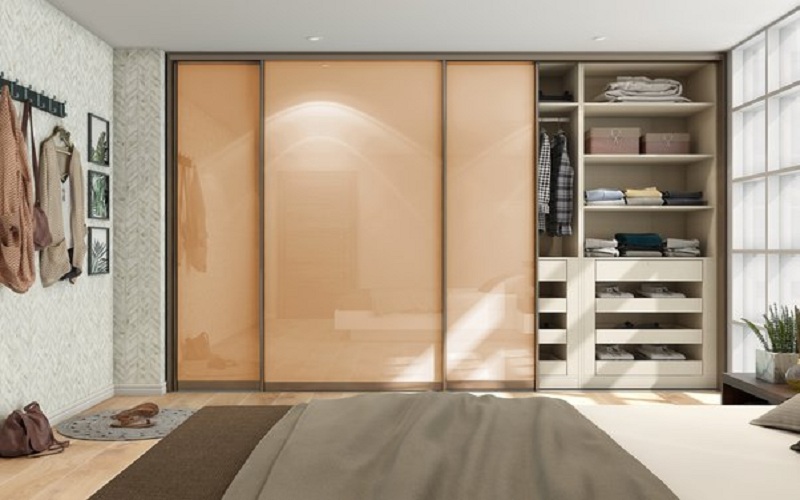Sliding wardrobe doors have become a popular choice in modern home design, offering both functionality and aesthetic appeal. They save space, provide easy access to clothing and accessories, and can be customized to match the décor of your bedroom plan. However, when choosing sliding wardrobe designs, one of the most important decisions is selecting the right material.
Here’s a detailed look at the various materials used for sliding wardrobe doors and their advantages.
Glass
Types of Glass
- Clear Glass: Offers a sleek, modern look and allows visibility into the wardrobe.
- Frosted Glass: Provides privacy while still allowing light to pass through, adding a touch of elegance to your interior house design.
- Tinted Glass: Comes in various shades and offers a stylish appearance with additional privacy.
- Mirrored Glass: Reflects light and creates the illusion of more space, making it ideal for smaller interior house design.
Advantages
Glass doors are visually appealing and can make your bedroom plan appear larger and brighter. They are easy to clean and can be combined with other materials like wood or metal frames to enhance their durability and style.
Wood
Types of Wood
- Solid Wood: Offers a classic, timeless look and is highly durable.
- Engineered Wood: Includes options like MDF (Medium Density Fiberboard) and plywood, which are cost-effective and versatile.
- Veneered Wood: Combines a thin layer of natural wood over a composite core, offering the beauty of real wood without the high cost.
Advantages
Wooden sliding doors add warmth and elegance to your bedroom plan. They are available in various finishes, stains, and paint colors, allowing for customization to match any décor. Solid wood doors are particularly durable and long-lasting, while engineered wood options offer affordability without sacrificing quality.
Metal
Types of Metal
- Aluminum: Lightweight, rust-resistant, and available in various finishes.
- Steel: Strong and durable, often used in industrial or contemporary designs.
Advantages
Metal sliding doors are highly durable and require minimal maintenance. Aluminum doors, in particular, are resistant to corrosion and can be powder-coated in different colors to suit various interior styles. Metal frames can also be combined with other materials like glass or wood to create a unique and stylish look.
Laminate
Types of Laminate
- High-Pressure Laminate (HPL): Known for its durability and resistance to scratches and moisture.
- Low-Pressure Laminate (LPL): More affordable but less durable than HPL.
Advantages
Laminate sliding doors are affordable and come in a wide range of colors, patterns, and textures. They can mimic the appearance of natural materials like wood or stone, offering versatility in design. Laminate doors are also easy to clean and maintain, making them a practical choice for busy households.
Acrylic
Types of Acrylic
- High Gloss Acrylic: Offers a shiny, reflective surface that adds a modern touch.
- Matte Acrylic: Provides a smooth, non-reflective finish for a more subdued look.
Advantages
Acrylic sliding doors are lightweight, durable, and resistant to moisture and UV rays. They are available in various colors and can be customized with different finishes. High gloss acrylic doors, in particular, create a sleek, contemporary appearance, while matte options offer a more understated elegance.
PVC
Types of PVC
- Rigid PVC: Provides strength and durability, suitable for long-term use.
- Flexible PVC: Offers more flexibility but is generally less durable than rigid PVC.
Advantages
PVC sliding doors are cost-effective and available in a wide range of colors and finishes. They are resistant to moisture and insects, making them suitable for humid environments. PVC doors are also easy to install and maintain, offering a practical solution for budget-conscious homeowners.
Composite Materials
Types of Composite Materials
- WPC (Wood Plastic Composite): Combines wood fibers and plastic, offering the best of both worlds.
- FRP (Fiber Reinforced Polymer): Combines fiberglass with resin, providing high strength and durability.
Advantages
Composite materials offer the appearance of natural materials like wood or stone with added durability and resistance to moisture, insects, and wear. They are versatile and can be customized in various colors and finishes, making them suitable for different interior styles. Composite doors are also environmentally friendly, as they often use recycled materials.
Choosing the right material for sliding wardrobe designs is essential for achieving the desired look and functionality in your space. Whether you prefer the elegance of glass, the warmth of wood, the durability of metal, or the versatility of laminate, acrylic, PVC, or composite materials, there is a perfect option to suit your needs. By understanding the advantages of each material, you can make an informed decision that enhances both the aesthetics and practicality of your wardrobe.

